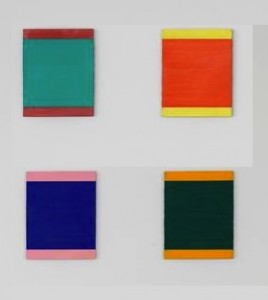Blinky’s semaphore
On what has become a frequent five-hour commute for me into New York City (ten hours, round trip), I decided to take the Thruway and detour over the Hudson River to Bard College to check out Blinky Palermo. He’s a German who painted in the 60s and 70s, in both Europe and New York City, and who died, apparently of a drug overdose, at the age of 33. The show has gotten so much attention I had to see it. Two days later, on my way home, I visited Dia:Beacon, a little further south along the river, to see his final work in the other half of the joint retrospective. If you’re going to see one or the other, check out the Dia show. When I say it’s his later work, I mean only a few years later, yet it’s far superior to what he’d done before, with only a few exceptions. (And Dia:Beacon is a trip in itself, pretty much a Grand Monastery of Modernism, an awe-inspiring, silent, light-filled structure, formerly a Nabisco factory, and it reminded me of a chilling set out of Kubrick. The other work, surrounding the Palermo show, makes you think long and hard about how many ways the art of the 20th century could terminate in so many different stylistic dead ends.)
The Bard show was extremely uneven, and it included a room of shaped canvases and constructions that might be referred to as the Laurel and Hardy Period, pairings of tall, skinny stick-like objects beside squat, bulky ones. They’re not well-crafted, maybe intentionally, but the impression you get is that he tossed them off as notations more than finished work, though they can make you smile. One turned out to be a chalkboard complete with chalk tray still attached, completely disguised with fabric cocooned over the front, and it’s puzzling until you see the title and figure it out and smile, which is not to say you aren’t still puzzled about why we need a shrouded chalkboard mounted and framed under glass. So much of Palermo has the duplicity of an inside joke: is he really committed to what he’s doing, you wonder, or just dead serious, like a professional comic, about wanting to amuse. Palermo often seems a bit of the prankster whispering wisecracks from the back pew. The real rewards of the Bard show are the few large “paintings” he did, stretching unpainted fabric—it looks like silk dyed with beautiful subtle tones—to create what might be hard-edge minimalist homages to Rothko. It’s lovely, simple, elegant work and it was probably just his way of saying, hey, check it out, who needs paint?
Yet his most focused innovations with color can be found at Dia:Beacon. It feels as cavernous as a hangar, and as you move from Sol LeWitt to Dan Flavin to Agnes Martin and then Robert Ryman, you realize you’re seeing almost nothing but different shades of white. Martin’s canvases seem to be fields of frost with stripes of various pastels bleeding decorously up from underneath, and Sol LeWitt’s line-covered walls make you their puppet for a while, pulling you from room to room, yet the impression you get is that all these artists were trying hard to disappear into the Void. After all this surrounding erasure, Palmermo’s jazzy colors, painted on metal squares and rectangles, feel like impulsive affirmations. The largest segment of the show seems repetitive, a sort of penance done every which way, all stripes and rectangles painting in different combinations of the same three colors: red, black and a deep, rich yellow. It’s like a long blues riff performed with only three notes. The real prize of the show comes near the end of exhibit—Coney Island II—four small metal panels in a row, Palermo’s own private semaphore, in colors that sing and seem to intensify as you watch them.

Comments are currently closed.